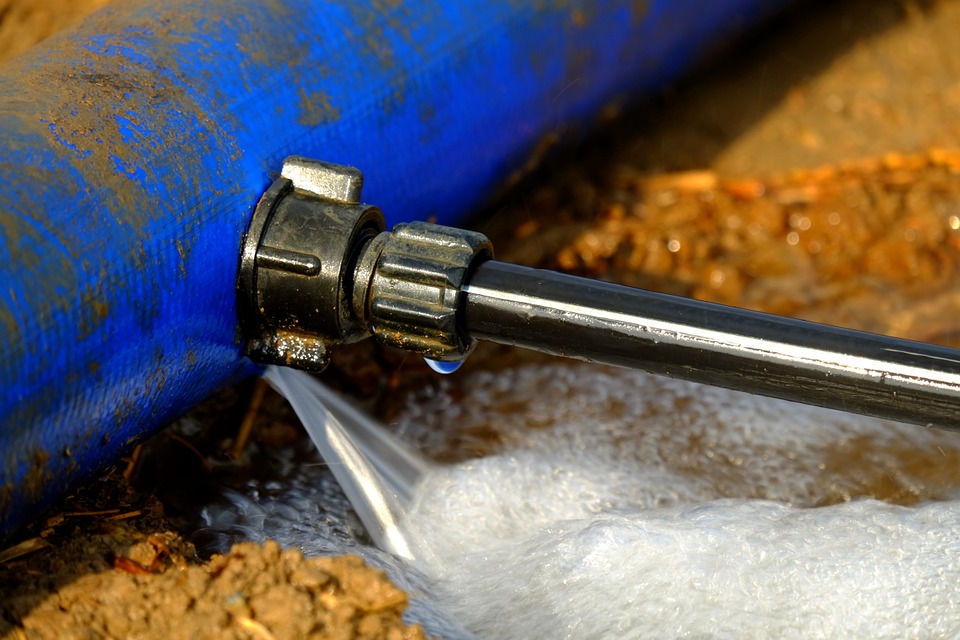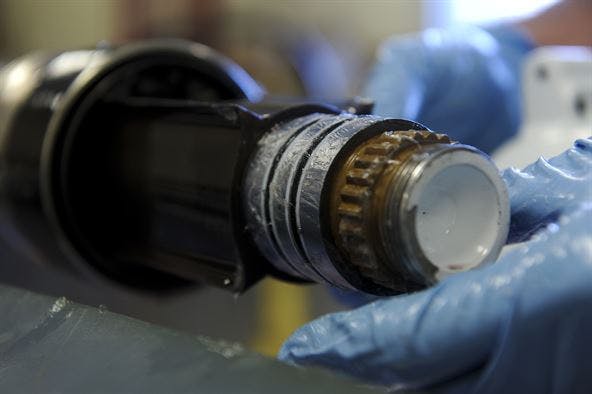When most people think of a hydraulic fluid leaks, they envision a puddle of fluid on the floor and the need to locate a hole in a hydraulic hose or perhaps a leaking seal. However, not all leaks reveal themselves as puddles, and not all leaks can be solved so easily. And even though a leak may seem minor, it can lead to excessive maintenance and operational costs, poor performance, a lack of reliability, and accelerated component wear. Tracking down the source of a leak (whether it is internal or external) can be difficult, but doing so will save unnecessary expenses later on.
External Hydraulic Fluid Leaks
The most obvious type of hydraulic leak is an external leak, which refers to a leak that allows hydraulic fluid to unintentionally exit the system. Some of these leaks can have obvious origins, such as a hydraulic line that has begun to spew fluid at high pressure from a small tear or hole in the line. Others, however, can be tricky because the place where the fluid gathers (e.g., a puddle on the floor or on the machine itself) is not necessarily in the same place that the hydraulic fluid is actually exiting the system. Leaks can easily drip and run from place to place if their source is high on the machine.
Effects of External Hydraulic Leaks

External hydraulic leaks can cause several problems, with the most costly being wasted fluid. Even a steady drip will add up over time, and leaks usually mean that the hydraulic fluid levels need to be topped off. Depending on where the leak takes place (inside a warehouse where it gathers on a concrete floor or on a hydraulic excavator where it leaks into the topsoil or grass), there can be environmental fallout for allowing a leak to continue unchecked. When puddles or slick areas begin to form, there is also a danger to operators and technicians (remember that falls and slips are a major cause of OSHA reports) that can lead to potential liability. In addition, leaks can also cause problems for technicians, resulting in fluid penetration injuries.
If the external leak is related to a worn-out seal or a hole in a non-pressurized line, that means that contaminants such as dust, moisture, and air can make their way into the system and cause even more problems. While it may seem easier to just keep topping off hydraulic fluid levels, it is not the best approach for this very reason: you can add more fluid, but you cannot undo the damage that is caused by the ingression of abrasive contaminants. Also, a lack of sufficient hydraulic fluid can accelerate the wear of components and lead to internal leaks that reduce performance and efficiency.
Tracking Down The Source of External Leaks
Visual inspection is the primary means of tracking down the source of an external leak, but this requires external cleaning of the equipment so that the fluid can be spotted at its origin. Visual methods such as this are often enhanced through the use of a dye-additive to the fluid that will not compromise its performance but allows leaks to show up under a black light. Tracking down external leaks is usually easier than tracking down the source of an internal leak, but still takes time and careful attention to detail. In addition, records regarding fluid level measurements may be of assistance during this process.
Addressing External Leaks

Most external leaks are the result of failed seals (and, in most cases, they have merely exceeded their limited useful life), connections, hydraulic hoses, or pipes. If holes or cuts are found in hoses, then additional effort needs to be made to prevent the same damage from occurring to a new line (e.g., use of a protective covering, rerouting the line). Loose or broken connections can be quickly resolved, although leaking pipes may prove a bit more of a challenge.
Internal Hydraulic Fluid Leaks
Internal leaks, as the name implies, are leaks that take place within the hydraulic system. Some of these leaks are intentional and take the form of narrow pathways or small orifices that allow hydraulic fluid to fly from an area of high pressure to an area of low pressure in order to cool or clean specific components. In addition, the leak never causes the fluid to exit the hydraulic system. However, problems can arise in the system and cause internal leaks to increase to the point that they negatively impact system performance.Causes of Internal Hydraulic Leaks

There can be various causes behind internal leaks, including wear of component surfaces, poor system design, incorrect control tolerances during initial manufacture or rebuilds, or the use of incorrect parts. The most common is basic wear and tear of components: as the surface of certain components begins to wear away, there is additional volumetric space for fluid to pass by these components, thus resulting in higher internal leakage.
Effects of Internal Leaks
One of the most obvious signs of an internal leak is a drop in system performance and efficiency. This is often accompanied by reduced reliability and lower efficiency, all of which will grow worse over time. It is not uncommon to also see a measurable increase in operating temperatures.
When internal clearances grow too large between the valve body and the spool on a spool valve, then you can expect some degree of system instability, control issues, and poor efficiency due to energy losses. In the case of hydraulic cylinders, either the drift/creep of the cylinder rod or the inability of the cylinder to sustain the load it is designed for are both manifestations of internal leakage in connection with a hydraulic cylinder. Relief valves that are stuck in an open position can also result in internal leakage.
Pumps and motors can be another major source of internal leakage problems and are usually the source of major leakage problems. The cause of internal leaks on pumps and motors is simple: excessive clearance between components that leads to a significant loss in volumetric efficiency (also known as slippage).
Tracking Down the Source of Internal Leaks

When internal leaks are suspected, it can be quite challenging to detect the cause and track down the source. The first step taken by a knowledgeable hydraulic technician would be the installation of flow meters in various locations throughout the hydraulic system to aid in narrowing down where the leakage is taking place. In fact, flow meters are often installed on the case drains of hydraulic motors and pumps to aid in detecting when sufficient wear has taken place to cause unplanned internal leakage. Potential leaks in connection with hydraulic cylinders and control valves can be detected by bench testing. Temperature measurement and ultrasonic detection are also key to detecting losses and the internal leaks that cause them.
Eliminating Internal Leaks
If the cause of the leak is an excessive clearance (which it most likely is), then the part in question will need to be replaced. While resurfacing critical components may be possible in certain cases, it can be difficult to restore surfaces that have been worn away. Note, however, that in most cases it is only certain parts that need to be replaced rather than an entire pump, motor, or cylinder assembly. However, if the parts in question show signs of premature wear, then extra effort must be made to find out what is causing the premature wear (e.g., wrong viscosity hydraulic fluid, contamination by abrasive particles, exceeding recommended operating temperatures).
Conclusion
Even a small dripping leak can add up: just one drop per second is equal to 420 gallons of hydraulic fluid wasted over a 12 month period. Beyond the obvious money lost in topping off those fluid levels, there is also the potential for environmental damage or employee injury. And if that leak is due to a failed seal, then there is a good chance that dust and moisture can begin to contaminate the remaining hydraulic fluid. Unintended internal leaks, while not as messy, are just as serious: reduced performance, less efficiency, and reliability issues are the result of internal leaks. Whether a leak is internal or external, it must be addressed without delay. Even though the downtime for finding and repairing a leak may seem cost-prohibitive, it will save money in the long run.
MAC Hydraulics
The skilled technicians at MAC Hydraulics can track down the source of a leak no matter how elusive it may seem and then address the issues causing that leak so that it does not reoccur. Our service trucks are outfitted with the equipment needed to diagnose, troubleshoot, and repair your hydraulic systems. In addition, our trucks carry the most commonly needed replacement parts, including seals and hoses, to get your equipment back online as soon as possible. Along with our 24-hour emergency repair services, MAC Hydraulics also offers customized maintenance plans to meet your preventative maintenance needs and goals. Contact us today to find out how we can help your system achieve peak performance!

